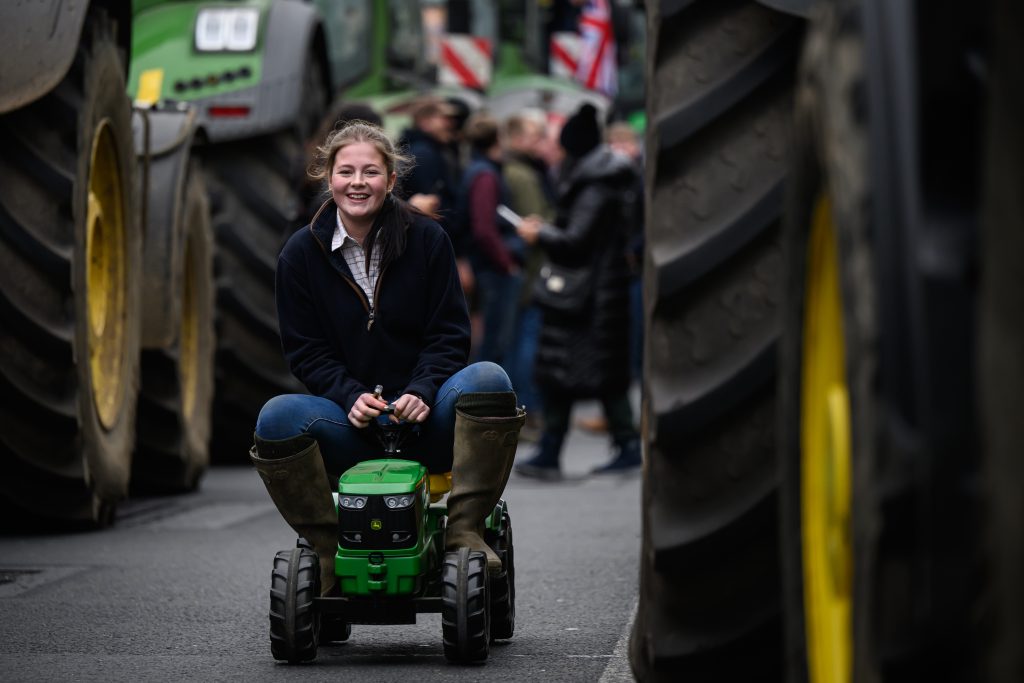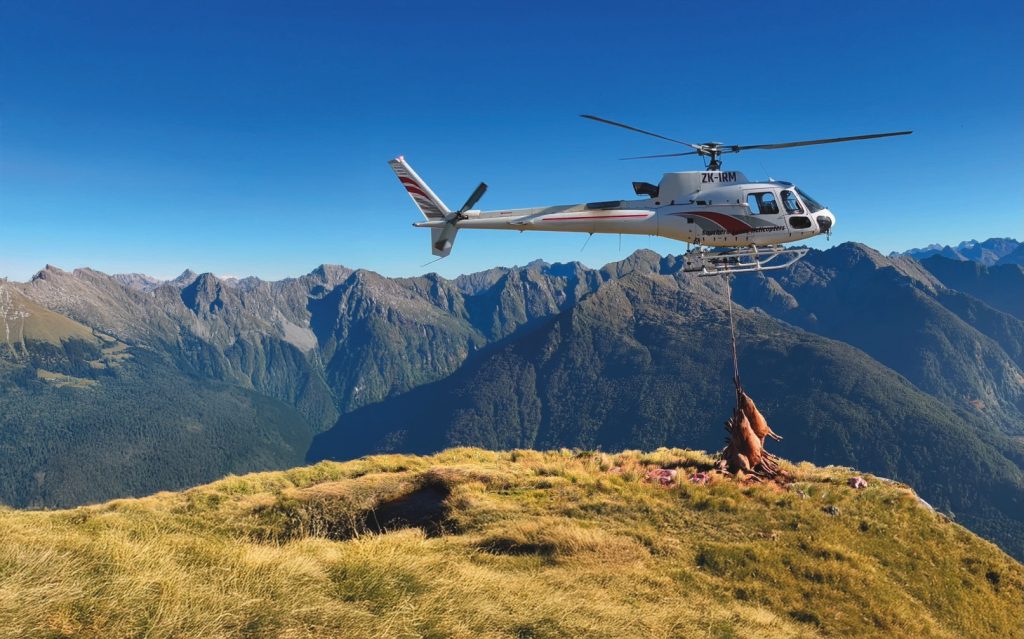Win CENS ProFlex DX5 earplugs worth £1,149 – enter here
Pigeon shooting with a moderated shotgun
After a dozen or so shots at best, the pigeon flock simply switched off, reset their Sat-Navs and shifted somewhere safer...
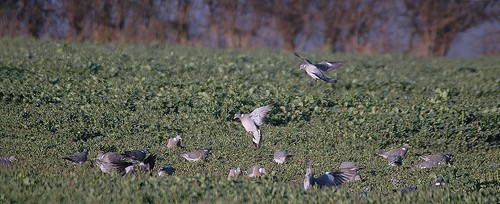
Ahead of the truck, I picked up the flight line a field away! Several small bunches and ones and twos were coasting in over the road towards the rape.
The bulk of the flock was already busy on a backward strip along the lee side of the far hedge, sheltered from a brisk south-westerly wind. There were lots!
What’s more, instead of the expected tight, wary pack, working as one bird, these looked very different. Moving well, and coming from several directions, new arrivals were tacking in every few minutes.
The set-up looked good!
With stronger winds forecast, it looked as though it might just be worth lugging all that heavy gear out, yet again, next morning. But what gun to use?
Last autumn, I’d bought the sound moderated, pump-action .410 for just this situation – but was it man enough for the job?
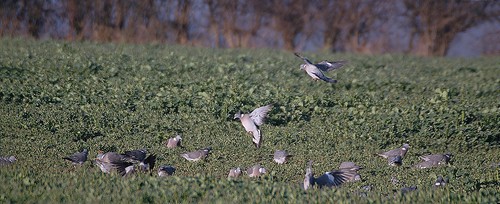
With little or no noise to disturb the wood, maybe they’d keep on longer – if I could just draw them in close enough. Everything needs decoying rather more precisely to the smaller gun, so I’d ditch the rotary in favour of the flapper.
The fresh pigeons were all at the game dealers, so the artificial decoys would have to do. Early next morning a dozen shells were grouped about 20 yards out; nets staked over the nearby ditch and the little three-shot was primed for action.
A decent breeze was already wafting in from behind – which should help to channel them in close enough. The first taker went straight on the flapper, improving the set-up ten-fold by the addition of movement.
At the kick-off things looked promising. The flight line was spot on, plenty close enough and everything plunged straight in… but this often happens at the start.
Leaving the few bigger lots un-shot, there were still enough ones and twos to reach double figures quite quickly. Some turned away as the sun broke through, but nipping out to replace the shells with fresh birds soon sorted that one.
The score was helped along by the strong back wind. At the first shot – muffled by the moderator – the rest invariably ploughed upwind, barely above head height, giving plenty of scope for dropping a second into the ditch.
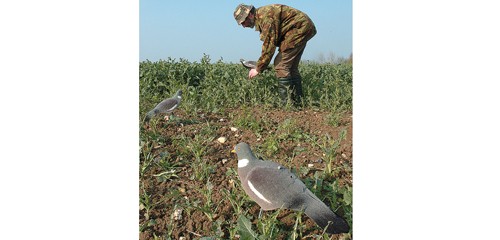
Only mildly bothered by the shooting, the second was, if anything, often rather too close for the tiny full choke pattern, but I wasn’t complaining! The three-inch cartridges certainly packed a lot more punch!
Though louder, the sound travels no distance, certainly not enough to roll like thunder through the nearby woods. Look at it from the pigeons’ point of view. If a bird glides in, then apparently drops among the decoys without a sound, everything appears normal.
Others watching are tempted to follow it, and I’ve sometimes had a drawn-out string of birds come in, one after the other, seeming oblivious to what’s happening. You’ve got to keep your wits about you with a .410; total concentration on each and every shot.
Believe me, placing such a tiny charge regularly and effectively on wind-rocked pigeons takes a bit of doing.
The occasional string of easy misses makes me long for the slightly bigger pattern of the 28-bore, but today it was safely tucked up in the gun cupboard – I just had to make the best of it. There was one really bad spell.
Missing a huge target hovering over the flapper gave the confidence a knock. I pumped another through – also wide – and slamming in the third, was a foot or so behind an easy crosser breaking out the side.
The frustration caused me to break one of my sacred rules – firing at the next incoming flock, thus scaring the living daylights out of lots of birds at once without touching a feather.
That was the last I’d see of that particular bunch – not the way to improve the score! It was time to calm down, take a deep breath and start again.
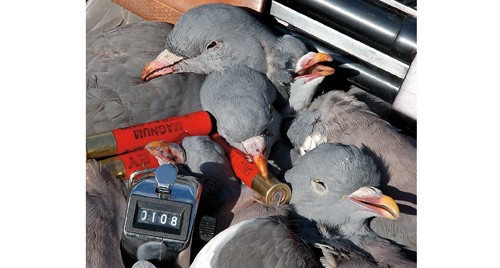
Concentrating on the next of a pair, it collapsed in a puff of feathers, and there was plenty of time to knock out its companion coming over the hedge. That was more like it. Whatever the gun, it pays to take your time, make sure of the first shot and keep your cool.
There’s loads of time. A string of clean kills emphasised this. Confidence returning, I began to relax. The difference was remarkable. There was a good blow now, and everything was coming well.
Using the odd lull to tidy up, picked birds were hidden among brambles further along the ditch. By mid-morning – normally the cut-off point on this patch – they showed little sign of stopping, arriving every few minutes to give comfortable head-on or crossing shots.
My best effort to date with the .410 was 80 birds, but I’d beaten it by noon, and I began to think about the magic 100!
Bad move. After coming really well, most flights usually fizzle out gently, but this was instant. One minute I was busy stuffing in cartridges, the next there was nothing. Not a bird in the sky, above the wood – or anywhere! I was only 17 short and it was still quite early. Surely they would come again?
It all went horribly quiet. To pass the time I picked up the fallen and tidied the decoy area. Even the freshest birds still had empty crops, so they’d not gone elsewhere – yet! Wrong again.
Following a long wait, hopes were dashed as a big strung-out bunch went winging away to the east. They knew where they were going. Unfortunately, so did I – a dozen acres of late rape lay just two fields away. No gas-guns, nobody shooting, completely quiet and undisturbed. Who could blame them?
Scraping those last few together just didn’t look like happening, but eventually, one peeled off a high passing group, set its wings and fell, ending close in over the decoys looking for somewhere to land.
I gave it a helping hand. Others had seen it drop, starting off another little burst of encouragement as more turned back.
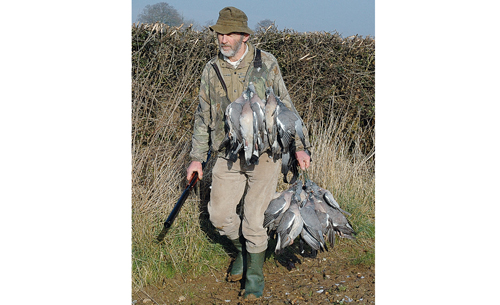
Soon they were planing in again from all directions. Each time, I tried to make sure of at least one bird.
A good clean kill with the first shot gives confidence for the second, and even with the .410 there’s usually plenty of time. With the pump action, I don’t even think about a third, though it’s happened a couple of times. Scoring well, the clicker was soon just a couple short of three figures.
A tense few minutes passed before one peeled off another high bunch, closing its wings and falling all the way, taken just as it levelled up to land. One to go!
The next big lot swooped confidently in, one picked from the confusion of wings, and another toppled as they swept up and over the hedge. A few stragglers followed as I bagged up the empty cases and put the gear together, and after drawing stumps, clearing up and doing a head count, the total was 108.
The gun had proved itself. It was certainly up to the job in such a situation – providing I was! It would add that little edge of confidence next time out. Would I have got more with the 28?
I’ve been asking myself the same question.
Certainly, if they’d kept coming exactly the same, I’d have taken more. But if past experience was anything to go by, with shots rattling through the nearby woods where they were working from, I think the misses were more than compensated for by the extended flight.
Well, that was virtually the last of the late spring rape – I can’t wait to get tucked up over a bit of laid barley!
Related Articles
Get the latest news delivered direct to your door
Subscribe to Shooting Times & Country
Discover the ultimate companion for field sports enthusiasts with Shooting Times & Country Magazine, the UK’s leading weekly publication that has been at the forefront of shooting culture since 1882. Subscribers gain access to expert tips, comprehensive gear reviews, seasonal advice and a vibrant community of like-minded shooters.
Save on shop price when you subscribe with weekly issues featuring in-depth articles on gundog training, exclusive member offers and access to the digital back issue library. A Shooting Times & Country subscription is more than a magazine, don’t just read about the countryside; immerse yourself in its most authoritative and engaging publication.






